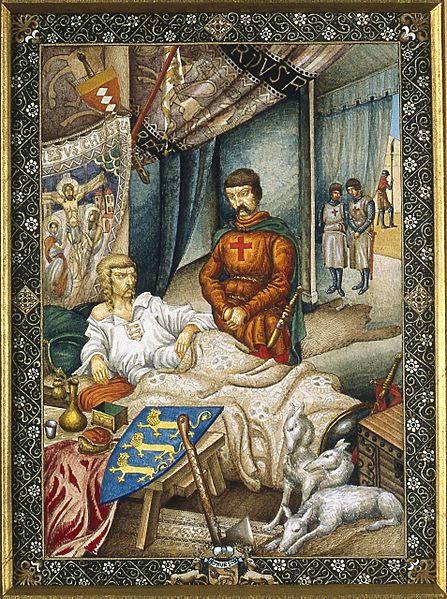Image: Arthur Szyk (1894-1951). Le Talisman, The Lionheart Lies in his Pavilion (1927), Paris

Description: This romantic, intricately detailed illumination portrays a scene from Le Talisman, one of the stories from Sir Walter Scott’s The Tale of the Crusaders originally published in 1825. Richard the Lionheart (Richard I) having become “afflicted with one of those slow and wasting fevers peculiar to Asia” is reclining on a bed inside his elaborately decorated tent during the Crusades. Wolf-greyhounds at his feet, his crown, drinking vessel and various implements of mortal combat (axe, swords and dirks) are strewn around the ailing monarch. He is being nursed by a fellow military comrade, Sir Thomas DeVaux of Cumberland.The 19th century saw the romance of the Crusades hoisted to dazzling heights. The Age of Chivalry and the retelling of the struggle, against the infidels, for the liberation of Jerusalem, made for lustily read novels. In The Talisman, Sir Walter Scott sets the very real King Richard I (1157-1199) against the backdrop of these Holy Wars. During Richard’s own lifetime he was often the subject of troubadour ballads and new myths appeared daily. Scott placed him in possession of a mystical Saracen talisman that held the power to cure miraculously.The details of this original miniature by Arthur Szyk incorporate astonishing jewel-cut embellishments. The image of a King’s war tent is intricately painted with oriental rugs, a vivid tapestry of the crucified Christ and a slim view of the battlefield beyond the tent flap. Richard’s heraldic emblems, the three lions are depicted twice. History tells us that he was the first King of England to make such use of a coat of arms. Arthur Szyk obviously read The Talisman very closely to be so faithfully accurate to Scott’s description. This painting truly illuminates the words upon the page. To our knowledge the several paintings Szyk created for The Talisman were never published or utilized to illustrate Walter Scott’s novel. Proof of his intent is shown beginning early in 1927 when Szyk made the following five diary entries: Jan. 6--- “Got up early. During the morning I sketched 4 planches for the Talisman.”Jan. 10--- “Got up early. Worked on Talisman.”Jan. 11--- “Got up early. Continued working on the Talisman.”Jan. 12--- “Got up early. Worked on the Talisman.”Jan. 13--- “Got up early. Finished fourth planche for the Talisman.”Astoundingly, this provides evidence that the four existing Talisman miniatures were all completed within eight days during Szyk’s richly productive Paris period when his 16th century illuminator’s style had matured into full realization. These were the same years during which he produced his Le Tentation de Saint Antoine, Le Puits de Jacob, as well as The Book of Esther.
Title: Arthur Szyk (1894-1951). Le Talisman, The Lionheart Lies in his Pavilion (1927), Paris
Credit: The Arthur Szyk Society, Burlingame, CA (www.szyk.org)
Author: Arthur Szyk
Permission: This work is free and may be used by anyone for any purpose. If you wish to use this content, you do not need to request permission as long as you follow any licensing requirements mentioned on this page. The Wikimedia Foundation has received an e-mail confirming that the copyright holder has approved publication under the terms mentioned on this page. This correspondence has been reviewed by an Volunteer Response Team (VRT) member and stored in our permission archive. The correspondence is available to trusted volunteers as ticket #2015030210000935. If you have questions about the archived correspondence, please use the OTRS noticeboard. Ticket link: https://ticket.wikimedia.org/otrs/index.pl?Action=AgentTicketZoom&TicketNumber=2015030210000935
Usage Terms: Creative Commons Attribution-Share Alike 4.0
License: CC BY-SA 4.0
License Link: https://creativecommons.org/licenses/by-sa/4.0
Attribution Required?: Yes
Image usage
The following page links to this image:

